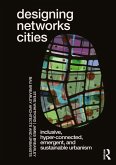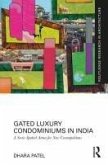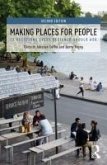Designing Gender Sensitive Spaces for Consenting Cities
Practices and Provocations
Herausgeber: Bawden, Gene; Moore, Timothy; Kalms, Nicole; Berry, Jess
Designing Gender Sensitive Spaces for Consenting Cities
Practices and Provocations
Herausgeber: Bawden, Gene; Moore, Timothy; Kalms, Nicole; Berry, Jess
- Gebundenes Buch
- Merkliste
- Auf die Merkliste
- Bewerten Bewerten
- Teilen
- Produkt teilen
- Produkterinnerung
- Produkterinnerung
This edited collection investigates gender-sensitive spaces, design practices, and provocations that challenge the complex social and material structures that shape inequities of access and inclusion in the urban environment.
Andere Kunden interessierten sich auch für
![Designing Networks Cities Designing Networks Cities]() James BrearleyDesigning Networks Cities163,99 €
James BrearleyDesigning Networks Cities163,99 €![Urban Food Mapping Urban Food Mapping]() Urban Food Mapping163,99 €
Urban Food Mapping163,99 €![Sustainable Lessons from People-Friendly Places Sustainable Lessons from People-Friendly Places]() Avi FriedmanSustainable Lessons from People-Friendly Places163,99 €
Avi FriedmanSustainable Lessons from People-Friendly Places163,99 €![Gated Luxury Condominiums in India Gated Luxury Condominiums in India]() Dhara PatelGated Luxury Condominiums in India170,99 €
Dhara PatelGated Luxury Condominiums in India170,99 €![Place and Placelessness Revisited Place and Placelessness Revisited]() Place and Placelessness Revisited238,99 €
Place and Placelessness Revisited238,99 €![Affective Spaces Affective Spaces]() Federico De MatteisAffective Spaces44,99 €
Federico De MatteisAffective Spaces44,99 €![Making Places for People Making Places for People]() Christie Johnson CoffinMaking Places for People163,99 €
Christie Johnson CoffinMaking Places for People163,99 €-
-
-
This edited collection investigates gender-sensitive spaces, design practices, and provocations that challenge the complex social and material structures that shape inequities of access and inclusion in the urban environment.
Hinweis: Dieser Artikel kann nur an eine deutsche Lieferadresse ausgeliefert werden.
Hinweis: Dieser Artikel kann nur an eine deutsche Lieferadresse ausgeliefert werden.
Produktdetails
- Produktdetails
- Verlag: Taylor & Francis Ltd
- Seitenzahl: 312
- Erscheinungstermin: 18. März 2025
- Englisch
- Abmessung: 246mm x 174mm
- ISBN-13: 9781032911274
- ISBN-10: 1032911271
- Artikelnr.: 72005160
- Herstellerkennzeichnung
- Libri GmbH
- Europaallee 1
- 36244 Bad Hersfeld
- gpsr@libri.de
- Verlag: Taylor & Francis Ltd
- Seitenzahl: 312
- Erscheinungstermin: 18. März 2025
- Englisch
- Abmessung: 246mm x 174mm
- ISBN-13: 9781032911274
- ISBN-10: 1032911271
- Artikelnr.: 72005160
- Herstellerkennzeichnung
- Libri GmbH
- Europaallee 1
- 36244 Bad Hersfeld
- gpsr@libri.de
Jess Berry is a design historian and an associate professor at Monash University. She is a senior researcher at the XYX Lab, where her research focuses on gendered spatial practices. Her research explores how gender identities are articulated and mediated through, and by, fashion, architecture, and interior design in cities. Nicole Kalms is a professor in the Faculty of Art, Design, and Architecture and founding director of the Monash University XYX Lab, which leads national and international research in gender and place. The innovation of Kalms' research is the examination of digital, experiential, political, and material interventions collated to articulate both the shared and conflicted struggles of women and girls internationally. Her praxis repositions design as a strategic tool for challenging gender inequity. Her recent research has focused on public transport spaces for women and girls, gender-sensitive CPTED, and the use of participatory co-design to challenge gender-neutral urban policy. Timothy Moore is a founder of Sibling Architecture, Senior Lecturer in Architecture at Monash University, and the Curator of Contemporary Design and Architecture at the National Gallery of Victoria. As a researcher within XYX Lab, he looks at the relationship between gender, sexual identity, equity, and architecture. Gene Bawden is a communication designer and the head of Monash University's Design Department. His research interrogates the design of Australian domestic spaces constructed as a prescriptive but highly charged representation of cultural belonging, social alignment, and gendered expectation. Gene combines his knowledge of gendered spatial practices and his communication design expertise within collaborative research projects.
Designing gender-sensitive spaces for consenting cities: An overview
PART ONE: Designing approaches
Introduction: Designing approaches
1. In search of a method that works: the story of the gendered landscape of
Umeå
2. To go for a walk alone and be a woman
3. Designing gender-responsive housing/home: a feminist exploration
4. A super-duper wicked problem: expanding intersectional climate
adaptation
5. Data design and dissemination: visualising gender inequality statistics
for public audiences
PART TWO: Making material changes
Introduction: Making material changes
6. Kitchen Revolutions
7. Shared reading and place-making in the rural Australian city: mediating
climate crisis, marginality and gendered experience through collective
reading practices
8. Institutionalising Pride: the rise of the Pride Centre in Melbourne
9. Engendering justice: on (in)visibilities of penal design,
aestheticization of punishment and space of solidarity
10. Making room for the unexpected: street sex work and the indecorous city
11. Developing advocacy: insights from gender-sensitive placemaking
training in the public sector
PART THREE: The possibilities of night
Introduction: The possibilities of night
12. Untangling the relationship of fear, safety and accessibility in
night-time Kolkata
13. Feminist urban planning through community action and transformation:
the case of Nocturnas
14. Reclaim the night: women walk to reimagine nightlife
15. Pride of place: (re)imagining a queer Sydney during WorldPride
PART FOUR: Infrastructures of care
Introduction: Infrastructures of care
16. Feminist criteria for territorialising the caring city
17. Rethinking spatial analysis and analytics: Native, Black and Latina/x
feminist theories and methods for engagement, equity and justice
18. Eco-Feminist co-housing: a design approach
19. How it started/how it's going: real-time reflections* on a queer
research practice
PART ONE: Designing approaches
Introduction: Designing approaches
1. In search of a method that works: the story of the gendered landscape of
Umeå
2. To go for a walk alone and be a woman
3. Designing gender-responsive housing/home: a feminist exploration
4. A super-duper wicked problem: expanding intersectional climate
adaptation
5. Data design and dissemination: visualising gender inequality statistics
for public audiences
PART TWO: Making material changes
Introduction: Making material changes
6. Kitchen Revolutions
7. Shared reading and place-making in the rural Australian city: mediating
climate crisis, marginality and gendered experience through collective
reading practices
8. Institutionalising Pride: the rise of the Pride Centre in Melbourne
9. Engendering justice: on (in)visibilities of penal design,
aestheticization of punishment and space of solidarity
10. Making room for the unexpected: street sex work and the indecorous city
11. Developing advocacy: insights from gender-sensitive placemaking
training in the public sector
PART THREE: The possibilities of night
Introduction: The possibilities of night
12. Untangling the relationship of fear, safety and accessibility in
night-time Kolkata
13. Feminist urban planning through community action and transformation:
the case of Nocturnas
14. Reclaim the night: women walk to reimagine nightlife
15. Pride of place: (re)imagining a queer Sydney during WorldPride
PART FOUR: Infrastructures of care
Introduction: Infrastructures of care
16. Feminist criteria for territorialising the caring city
17. Rethinking spatial analysis and analytics: Native, Black and Latina/x
feminist theories and methods for engagement, equity and justice
18. Eco-Feminist co-housing: a design approach
19. How it started/how it's going: real-time reflections* on a queer
research practice
Designing gender-sensitive spaces for consenting cities: An overview
PART ONE: Designing approaches
Introduction: Designing approaches
1. In search of a method that works: the story of the gendered landscape of
Umeå
2. To go for a walk alone and be a woman
3. Designing gender-responsive housing/home: a feminist exploration
4. A super-duper wicked problem: expanding intersectional climate
adaptation
5. Data design and dissemination: visualising gender inequality statistics
for public audiences
PART TWO: Making material changes
Introduction: Making material changes
6. Kitchen Revolutions
7. Shared reading and place-making in the rural Australian city: mediating
climate crisis, marginality and gendered experience through collective
reading practices
8. Institutionalising Pride: the rise of the Pride Centre in Melbourne
9. Engendering justice: on (in)visibilities of penal design,
aestheticization of punishment and space of solidarity
10. Making room for the unexpected: street sex work and the indecorous city
11. Developing advocacy: insights from gender-sensitive placemaking
training in the public sector
PART THREE: The possibilities of night
Introduction: The possibilities of night
12. Untangling the relationship of fear, safety and accessibility in
night-time Kolkata
13. Feminist urban planning through community action and transformation:
the case of Nocturnas
14. Reclaim the night: women walk to reimagine nightlife
15. Pride of place: (re)imagining a queer Sydney during WorldPride
PART FOUR: Infrastructures of care
Introduction: Infrastructures of care
16. Feminist criteria for territorialising the caring city
17. Rethinking spatial analysis and analytics: Native, Black and Latina/x
feminist theories and methods for engagement, equity and justice
18. Eco-Feminist co-housing: a design approach
19. How it started/how it's going: real-time reflections* on a queer
research practice
PART ONE: Designing approaches
Introduction: Designing approaches
1. In search of a method that works: the story of the gendered landscape of
Umeå
2. To go for a walk alone and be a woman
3. Designing gender-responsive housing/home: a feminist exploration
4. A super-duper wicked problem: expanding intersectional climate
adaptation
5. Data design and dissemination: visualising gender inequality statistics
for public audiences
PART TWO: Making material changes
Introduction: Making material changes
6. Kitchen Revolutions
7. Shared reading and place-making in the rural Australian city: mediating
climate crisis, marginality and gendered experience through collective
reading practices
8. Institutionalising Pride: the rise of the Pride Centre in Melbourne
9. Engendering justice: on (in)visibilities of penal design,
aestheticization of punishment and space of solidarity
10. Making room for the unexpected: street sex work and the indecorous city
11. Developing advocacy: insights from gender-sensitive placemaking
training in the public sector
PART THREE: The possibilities of night
Introduction: The possibilities of night
12. Untangling the relationship of fear, safety and accessibility in
night-time Kolkata
13. Feminist urban planning through community action and transformation:
the case of Nocturnas
14. Reclaim the night: women walk to reimagine nightlife
15. Pride of place: (re)imagining a queer Sydney during WorldPride
PART FOUR: Infrastructures of care
Introduction: Infrastructures of care
16. Feminist criteria for territorialising the caring city
17. Rethinking spatial analysis and analytics: Native, Black and Latina/x
feminist theories and methods for engagement, equity and justice
18. Eco-Feminist co-housing: a design approach
19. How it started/how it's going: real-time reflections* on a queer
research practice








